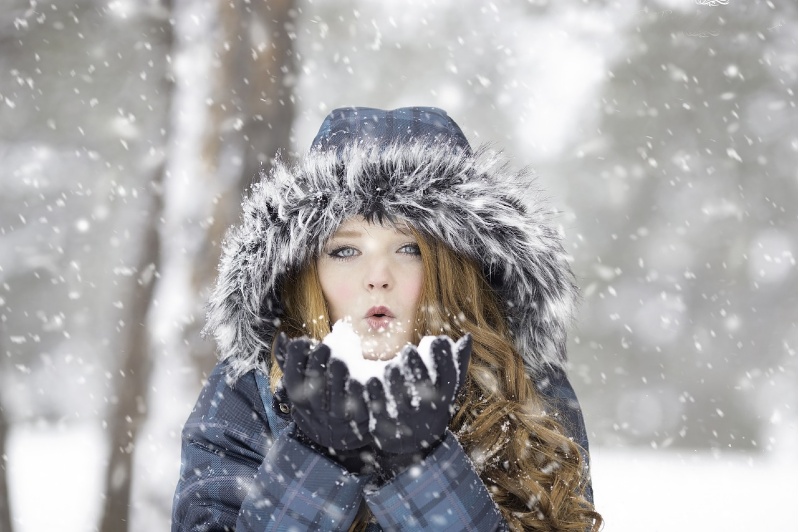
Here in Southwest Florida our winters are pretty mild — we might have the few odd cold fronts come through that occasionally drive the temperatures down into the 30’s, but for the most part the weather is pretty comfortable year round. Many of us find ourselves traveling for the winter holidays, though, so it’s a good idea to know how to keep your child safe, healthy, and protected should you find yourself in cold weather or snow during your travels.
Whether you stay here in Cape Coral for the holidays or your winter vacation brings you to a place with snow and cold temperatures, the Southwest Florida pediatricians here at MacKoul Pediatrics of Cape Coral have some valuable tips on how to keep your children safe and warm during the colder months.
Dress infants and children warmly for outdoor activities. Several thin layers will keep them dry and warm. If you are in snowy or icy conditions, be sure to not forget warm boots, gloves or mittens — and a hat! Choose boots that are large enough to comfortably accommodate two pairs of socks.
Remove drawstrings from clothing which may get caught on tree branches or play equipment. Replace with velcro.
The rule of thumb for older babies and young children is to dress them in one more layer of clothing than an adult would wear in the same conditions.
When riding in the car, babies and children should wear thin, snug layers rather than thick, bulky coats or snowsuits. Please see our Winter Car Seat Safety article for more information.
Blankets, quilts, pillows, bumpers, sheepskins and other loose bedding should be kept out of an infant’s sleeping environment because they are associated with suffocation deaths and may contribute to Sudden Infant Death Syndrome (SIDS). It is better to use sleep clothing like one-piece sleepers or wearable blankets. If a blanket must be used to keep a sleeping infant warm, it should be thin and tucked under the crib mattress, reaching only as far as the baby’s chest, so the infant’s face is less likely to become covered by bedding materials.
Hypothermia develops when a child’s temperature falls below normal because of exposure to colder temperatures. It often happens when a youngster is playing outdoors in extremely cold weather without wearing proper clothing or when clothes get wet. It can occur far more quickly in children than in adults.
As hypothermia sets in, the child may shiver and become lethargic and clumsy. Speech may become slurred and body temperature will decline in more severe cases.
If you suspect your child is hypothermic, call 911 at once. Until help arrives, take the child indoors, remove any wet clothing, and wrap them in blankets or warm clothes.
Frostbite happens when the skin and outer tissues become frozen. This condition tends to happen on extremities like the fingers, toes, ears and nose. Skin first becomes red and tingly, then gray and painful and finally white, cold and hard without pain. Blistering occurs after the skin thaws.
Prevent frostbite by dressing in layers, covering all body parts when outside in cold weather. Bring children indoors immediately if clothing gets wet.
Playing in temperatures or wind chills below -15 F should be avoided because exposed skin begins to freeze within minutes.
If frostbite occurs, bring the child indoors and place the frostbitten parts of her body in warm (not hot!) water. 104° Fahrenheit (about the temperature of most hot tubs) is recommended. Warm washcloths may be applied to frostbitten nose, ears and lips.
Administer acetaminophen or ibuprofen when you begin rewarming because as the skin thaws pain occurs.
Do not rub the frozen areas.
After a few minutes, dry and cover the child with clothing or blankets. Give him/her something warm to drink and seek medical attention immediately, particularly if blistering occurs.
If your child suffers from winter nosebleeds, try using a cold air humidifier in the child’s room at night. Saline nose drops or petrolatum may help keep nasal tissues moist. If bleeding is severe or recurrent, consult your pediatrician here at MacKoul.
Many pediatricians feel that bathing two or three times a week is enough for an infant’s first year. More frequent baths may dry out the skin, especially during the winter.
Cold weather does not cause colds or flu. But the viruses that cause colds and flu tend to be more common in the winter, when children are in school and are in closer contact with each other. Frequent hand washing and teaching your child to sneeze or cough into the bend of her elbow may help reduce the spread of colds and flu.
Children 6 months of age and up should get the influenza vaccine to reduce their risk of catching the flu. It is not too late to get the vaccine! Around 80% of all influenza illness generally occurs in January, February, and March.
Set reasonable limits on outdoor play to prevent hypothermia and frostbite and make sure kids have a place to go warm up when they get cold. When weather is severe, have children come inside periodically to warm up.
This should obviously go without saying with regards to teens and children, but alcohol or drug use should not be permitted in any situation. They can be even more dangerous in winter activities like snowmobiling or skiing.
Allow children to skate only on approved surfaces. Check for signs posted by local police or recreation departments, or call your local police department to find out which areas have been approved.
Advise your child to:
- Skate in the same direction as the crowd
- Avoid darting across the ice
- Never skate alone
- Not chew gum or eat candy while skating
Consider having your child wear a helmet, knee pads and elbow pads, especially while beginning to learn to skate
- Keep sledders away from motor vehicles.
- Children should be supervised while sledding.
- Children less than 5 years of age should not sled alone.
- Keep young children separated from older children.
- Sledding feet first or sitting up, instead of lying down head-first, may prevent head injuries.
- Consider having your child wear a helmet (hockey not bicycle) while sledding.
- Sleds should be structurally sound and free of sharp edges and splinters, and the steering mechanism should be well lubricated.
- Sled slopes should be free of obstructions like trees or fences, be covered in snow, not ice, not be too steep (slope of less than 30º), and end with a flat runoff.
- Avoid sledding in crowded areas.
- Children should be taught to ski or snowboard by a qualified instructor in a program designed for children.
- Never ski or snowboard alone.
- Young children should always be supervised by an adult. Older children’s need for adult supervision depends on their maturity and skill. If older children are not with an adult, they should always at least be accompanied by a friend.
- All skiers and snowboarders should wear helmets. Ski facilities should require helmet use, but if they do not, parents should enforce the requirement for their children.
- Equipment should fit the child. Skiers should wear safety bindings that are adjusted at least every year. Snowboarders should wear gloves with built-in wrist guards. Hip pads have been shown to be effective in preventing fractures as well. Eye protection or goggles should also be used.
- Slopes should fit the ability and experience of the skier or snowboarder. Avoid crowded slopes.
- Avoid skiing in areas with trees and other obstacles.
- The AAP recommends that children under age 16 not operate snowmobiles and that children under age 6 never ride on snowmobiles.
- Do not use a snowmobile to pull a sled or skiers.
- Wear goggles and a safety helmet approved for use on motorized vehicles like motorcycles.
- Travel at safe speeds.
- Never snowmobile alone or at night.
- Stay on marked trails, away from roads, water, railroads and pedestrians.
The sun’s rays can still cause sunburn in the winter, especially when they reflect off snow. Make sure to cover your child’s exposed skin with sunscreen and consider using sunglasses or goggles with UV protection. If you find yourself on vacation in the snow, make sure you are applying sunscreen to the bottoms of their nose and ears and under the chin area as well.
Winter is a time when many household fires occur. It is a good time to remember to:
- Buy and install smoke alarms on every floor of your home
- Test smoke alarms monthly
- Practice fire drills with your children
- Install a carbon monoxide detector outside bedrooms
- Keep space heaters at least 3 feet away from anything that could burn, and turn them off when leaving the room or sleeping
Call Your Local Cape Coral Pediatrician With Any Questions
If you have any questions about your child’s health or winter safety, there are plenty of qualified resources on the web that can help — and MacKoul Pediatrics of Cape Coral is only a phone call away at (239) 573-2001.
MacKoul Pediatrics is an amazing local pediatrics office in Cape Coral, FL where caring, compassionate doctors and nurses work with you to keep your children as healthy as possible. MacKoul cares for children from birth to college age, from Cape Coral, Fort Myers, Naples, and beyond.
November 29, 2017
 Here in Southwest Florida our winters are pretty mild — we might have the few odd cold fronts come through that occasionally drive the temperatures down into the 30’s, but for the most part the weather is pretty comfortable year round. Many of us find ourselves traveling for the winter holidays, though, so it’s a good idea to know how to keep your child safe, healthy, and protected should you find yourself in cold weather or snow during your travels.
Here in Southwest Florida our winters are pretty mild — we might have the few odd cold fronts come through that occasionally drive the temperatures down into the 30’s, but for the most part the weather is pretty comfortable year round. Many of us find ourselves traveling for the winter holidays, though, so it’s a good idea to know how to keep your child safe, healthy, and protected should you find yourself in cold weather or snow during your travels.